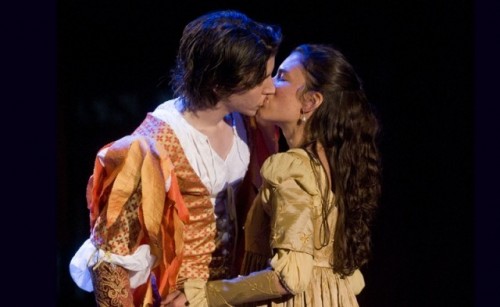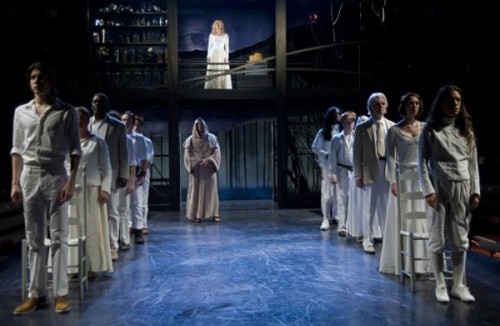Romeo and Juliet at Shakespeare & Company
O Romeo, Romeo, Where You At Romeo
By: Charles Giuliano - Jul 16, 2011
Romeo and Juliet
By William Shakespeare
Directed by Daniela Varon
Set Design, Sandra Goldmark; Costume Design, Kiki Smith; Lighting Design, Les Dickert; Composer and Sound Design, Scott Killian; Voice and Text Coach, Elizabeth Ingram; Fight Director, Edgar Landa; Choreographer, Susan Dibble; Casting, Ellisa Myers Casting; Stage Manager, Dian Healy.
Cast: Susannah Millonzi (Juliet), Malcolm Ingram (Lord Capoulet), Kelly Curran (Lady Capulet), Starla Benford (Nurse to Juliet), Equiano Mosieri (Tybalt), Kate Abbruzzese (Rosaline/ Abram/ Page to Paris), Paul D’Agostino (Sampson/ Tybalt’s follower/ Friar John/ First Watch), Wesley Cooper (Peter/ Petruchio/ Second Watch), David Gelles (Romeo), Johnny Lee Davenport (Lord Montague), Renee Margaret Speltz (Lady Montague), Sam Parrott (Benvolio), Ross Bennett Hurwitz (Balthasar), Tony Roach (Escalus), Kevin O’Donnell (Mercutio), Wolfe Coleman (Paris), Walton Wilson (Friar Laurence).
Shakespeare & Company
Founder’s Theatre
Running time just under three hours with intermission
July 8 to September 3, 2011
As a theatre that bears his name, Shakespeare & Company, there is a mandate to expose the Berkshire audience to the range of the canon. Over time to present both the familiar and often produced plays as well as those that are rarely seen.
On June 24, 2009 we wrote “Since January the production of Romeo and Juliet, with seven actors performing some 14 roles, has been performed in 70 schools and theatres throughout New England, New York and New Jersey. It is a part of the Shakespeare & Company Youth Program that has been directed by Jonathan Croy for over 20 years. The vital touring program is a mandate of Shakespeare & Company, founded 32 years ago by Tina Packer, to train young actors as well as to bring Shakespeare's work to 25,000 students and teachers each year.”
If Romeo & Juliet toured extensively and was staged successfully with great audience and critical success, just two seasons ago, why bring it back so soon with a new and larger production?
Is there too much of a good thing? Particularly when there is so much of the canon, with its endless challenges, that we are not seeing.
One of the most valuable and essential aspects of the enormously dense and ambitious project of Tina Packer and Nigel Gore, in the just ended run of the five part Women of Will, was to give a broad sense with many scenes and discussion of the full range of the canon. It created a real appetite to delve more deeply particularly into the lesser known plays.
During Women of Will Packer spoke with particular intensity about the role of Juliet as pivotal in the canon. Rather then the innocent, chaste, love child she was discussed as a rebel and aggressor. It is Juliet, a Capulet, who suggests marriage to her just met lover, and son of the hated Montague clan. For the era of the Bard she must have been remarkable in defying the wishes of her father to marry Paris. And to choose Romeo, her new husband, who has killed her kinsman Tybalt.
In Packer’s thesis Juliet is a strong woman, or is that maiden/ child?
So there are many options of how to play her and to present one of the most familiar and loved of all romantic tales. Of course the greatest challenge of the role is the age of Juliet. As written by Shakespeare, and performed at the time by boys, she must have the innocence of a fourteen year old virgin experiencing love for the first time. As well as the strength and maturity to follow her heart and defy the wishes of her father and marry the son of the hated enemy.
It was. of course, a stretch and leap of the imagination to see a mature and great actor like Packer perform the lines of a fourteen year old. But it is also just as challenging, in most other productions, as it is usual to cast a girl who is much older. As is the case with Susannah Millonzi, a girl/ woman in her mid twenties. The norm is to seek a female lead who looks younger than her actual age but has the skills to bring the necessary depth to the range of the role. That seems to be the intention here.
There are similar issues in casting an adequate Romeo who as written is about 16. Of course, by Torah, a boy is a man when he reaches 13, and joins the congregation through a bar mitzvah. In prior centuries, as we see in the play, a sixteen-year-old is mature enough to fight and die for the clan. If he is old enough to kill he is old enough to marry a fourteen year old.
By our perspective they are children and a concern of our society is teenage pregnancy. In prior centuries it was the norm. Girls didn’t put off marriage until after college and an MBA.
But in a true sense Romeo and Juliet are just children. They do not have the maturity and life experience to understand the consequences of their hormones and adolescent passions. Nor do they appear to have the council of their elders. Lord Capulet, strongly played here by Malcolm Ingram, just tells her what to do with violent threats if she does not obey. Juliet’s mother, Lady Capulet (Kelley Curran), is obedient to her husband and expects the same of Juliet. She is not one to confide in concerning matters of the heart. For that Juliet turns to her nurse (Starla Benford) in a compellingly earth performance. While Romeo appears to get no support or advise from his father, Lord Montague, played by the ever remarkable Johnny Lee Davenport. Mostly, Romeo receives the not very helpful advice of peers.
We come to S&Co. with the expectation of authentic and well considered productions of Shakespeare’s plays. It is the essence of what the company has focused on for more than 30 years.
Coming so soon after another S&Co. production of Romeo and Juliet the mandate is that the director, Daniela Varon, has something fresh and enticingly different to say about an overly familiar work. A classic we all know and have seen in endless incarnations.
This production is indeed top heavy with such ambitions. As the very long and rather arduous evening unfolds we experienced many new approaches and concepts. Some worked with stunning impact and others represented interesting, ambitious ideas that just fell flat as theatre. This complex mix of good, bad and indifferent left us with a muddled experience. It was a production that proved to be neither fish nor fowl.
A concept of the director was, as she states in program notes, “…we have chosen not to set the play in a particular time or place (other than its original Verona), nor to have the Montagues and Capulets represent a particular conflict. These families are more alike than they are different; they go to the same church and they have common friends. Their ‘ancient grudge’ is acknowledged but never explained, as much a part of the fabric and rituals of the community as is the ‘old accustom’d feast’ that the Capulets hold every year, pulling out the trunk full of traditional masks and costumes.”
OK, there seems to be enough ambition and innovation in the thesis of the director to warrant a full new production. To pull out all the stops with a large cast and the entire, though limited, resources of the company. With so many actors on staff, and many summer interns and students, an ambition is to get a lot of individuals on stage.
There were interesting design decisions. The most obvious and compelling was the set design by Sandra Goldmark using a thrust stage. This meant taking out a lot of seats in the orchestra. But that loss of potential ticket sales didn’t seem to matter as there was a small house, particularly for opening night. Another design decision was to go with a very bare and stark look with just a few Shaker inspired items of furniture used effectively. This included, in a daring director’s decision, to use chairs for the famous balcony scene. It entailed a suspension of illusion and navigated the romance ever more deeply into adolescent fantasy.
Usually the staging at S&Co., given budget constraints, is a consistent weak point. We have come to expect the bare pipe productions with a few props as ersatz sets. Of course the argument is that this is indeed how the plays were originally staged. But, with this production, that starkness became an engaging plus factor.
In creating that sense of any place, any time, any feuding family Varon, and costume designer Kiki Smith, opted for all white, contemporary, prêt a porter costumes. There was no color coding or heraldry to help us to identify the Montagues and the Capulets. The intention was to make those separations based on text and acting. Well, truth is, those all white contemporary costumes were just bland. Literally, a white out. White on white is best left to an artist like Kasimir Malevich. And that was a century ago.
Particularly when, with a blaze of color and pageantry, the feast at home of the Capulets was presented in glorious period costumes. That combined with the lively choreography of Susan Dibble, and the generally excellent music and sound design of Scott Killian, proved to be the richly dramatic highlight of an otherwise drab and monotonous evening. Too briefly the stage came alive and the production sparkled. Then, like three card monte and some theatrical shell game, the director picked the wrong shell and we went back to that all white thing. Boring.
Yes, we were distracted now and then by the well staged and energetic fight scene. Boys will be boys. Particularly when they are Montagues and Capulets.
Any production of this play vitally depends upon having a truly compelling pair of star-crossed lovers. This proved to be the fatal flaw. I just never believed any of the lines and emotions of David Gelles as Romeo. He seemed overwhelmed by the text and never managed any of the cadence, enunciation or poetry of the writing. It takes more than just raising your voice, as was also the case with the Mercutio of Kevin O’Donnell, to convey anger and strong emotion. There was way too much shouting in the directing of Varon. You never sensed that she got the actors to really feel their lines and inhabit the characters. Millonzi was an adequate but not very unique or compelling Juliet. The performance was uneven kind of waving in and out of focus. Some scenes played well, with conviction, others not.
Particularly, in the final death scene in the crypt. Why on earth did Varon stage that with Juliet, seemingly a corpse, sitting bolt upright? Good grief. Then ditto for the dead Romeo. It just nixed the notion of Juliet waking up from a drug induced sleep. It was such a mess Add to the chaos the killing and corpse of her suitor, Paris. There was such a clutter of characters and emotions in the tomb that it seemed like rush hour at Grand Central Station. It was an awkward conclusion of a production I had already given up on.
One of the great strengths of Romeo and Juliet is its focus on youth and opportunity to present a vehicle for young actors. That makes it a standard for high school and college productiions which this mostly resembed. It is what worked so well with that 2009 touring version by S&Co. We were just drawn in by the energy and skills of those young actors.
But here, what should be an asset, proved to be a liability. There was a sharp demarcation between the skill of mature actors like Ingram, Davenport and Benford to convey the depth of their characters, and the performances of juvenile actors, who generally fumbled and faltered. Indeed, as we saw on stage, it takes a lifetime to master the craft and here we encountered just glimpses of the potential of so many young actors.
Youth must be served. Maybe.







